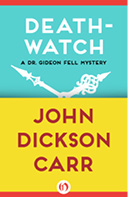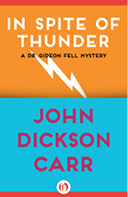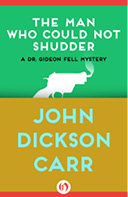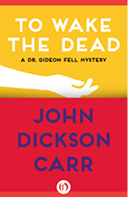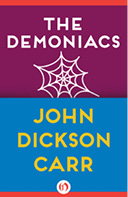Scandal at High Chimneys (29 page)
Read Scandal at High Chimneys Online
Authors: John Dickson Carr

Please restrain the ribald comment which already has crossed your mind. When a singer was received with disfavour by the audience, a critic could write, “She was goosed last night,” and mean only that the lady had failed to please. All slang terms in this novel have been verified against a contemporary authority,
The Slang Dictionary, or, The Vulgar Words, Street-Phrases, and ‘Fast’ Expression of High and Low Society
(London: John Camden Hotten, 1865). From this book comes the description of a
FAST
young lady quoted in chapter eight.
Let us return to the theatre, since there is a comparison here with Victorian life. In addition to being uncomfortable and rowdy, the stage had few good plays and no first-rate plays.
If the novelist laboured under many restrictions, the playwright was so much more fettered and even strait-jacketed by Mrs. Grundy that he had almost lost touch with human life. This was not so much the fault of Victorian life; it had been going on since the eighteenth century.
Consider what happened when
The Moonstone,
Wilkie Collins’s inoffensive detective novel, was dramatized at the Olympic Theatre.
In the original story, centered round the theft of the great orange-yellow diamond, Franklin Blake is loved by two women: the heroine, Rachel Verinder, and the deformed maid-servant, Rosanna Spearman. All are on an edge of nerves for fear the diamond will be stolen by a group of sinister Hindus….
(Sorry; this was a new idea in 1868.)
… and Franklin Blake, who has been sleeping badly, angrily swears nothing can make him sleep. The doctor, to teach him a lesson, secretly puts opium in his coffee. Still alarmed in his secret mind, Franklin Blake walks in his sleep and removes the diamond to a different hiding-place. The two women, who see him, believe he has stolen it knowingly, and are concerned to protect him. But Blake doesn’t know he is the thief and in all innocent fairness can tell his own story in the first person: thereby anticipating and bettering
The Murder of Roger Ackroyd
by nearly sixty years.
This wouldn’t do for the stage.
The hero must not take opium, even when he doesn’t know he is taking it. In the play he goes sleep-walking after an indigestible dinner, carrying things to the edge of farce. A servant-girl must not cherish an unholy passion which can never be crowned by marriage; and so Rosanna Spearman, the most moving and effective character in the book, is cut out of the play. These are not the only differences, but they will do.
If such a degree of “niceness” seems incredible, read Dutton Cook’s
Nights at the Play
(London: Chatto & Windus, 2 vols., 1883), containing selected theatrical notices by a leading dramatic critic during the sixties and seventies.
The playwright, for the most part, was reduced to bombast and fustian. Though the script of
It Is Never Too Late to Mend
is not available, allow me to quote some speeches from
Masks and Faces,
a very popular play which Charles Reade wrote in collaboration with Tom Taylor.
The central character is Peg Woffington, Garrick’s girlfriend, beloved of audiences because she could be shown as a noble-minded if abandoned actress destined for a no-good end. Here she speaks to Mabel Vane, the heroine:
“Such as you are the diamonds of this world! Angel of truth and goodness, you have conquered. The poor heart which we both overrate shall be yours again. In my hands ’tis but painted glass at best; but, set in the lustre of your love, it may become a priceless jewel.”
Then, in a later speech, Peg really hits it for six:
“When, hereafter, in your home of peace, you hear harsh sentence passed on us, whose lot is admiration, rarely love; triumph, but never tranquillity, think sometimes of Margaret Woffington, and say, ‘Stage-masks may cover honest faces, and hearts beat true beneath a tinselled robe.’”
Thus the mid-Victorian stage—like mid-Victorian life—might be uncomfortable, at times rowdy, and hiding much that mustn’t be seen; but at least it expressed the most high-flown sentiments in public.
4 KEEP ALL THINGS DARK
The above is not written to mock or deride those who in so very many ways were our betters.
On the contrary, with Dickens and Thackeray, this age produced the two greatest English novelists of all time; and its poets have not been matched since then. The triumph of the Titans lies not in what they said but how they said it.
When Thackeray cuts loose with a denunciation of George the Fourth, all he is really saying (as the Victorian lady observed at a performance of
Antony and Cleopatra
) amounts to: “How different from the home life of our own dear Queen!” But he says it with such effective rhetoric that we are swept away.
The Titans, who were realists and knew their audience, knew also that they must conform to the pressure of public opinion—outwardly, at least—in their lives as well as in their books.
In 1857, when Charles Dickens was over forty-five years old, he fell violently in love with an eighteen-year-old actress named Ellen Ternan. It played havoc; it wrecked his already tottering marriage; it was not a happy relationship even after she had become his mistress.
His family and his friends knew of this relationship. And yet it was never so much as mentioned by any biographer until 1936, or dealt with at length until 1939. For a full discussion of this point, see Gladys Storey’s
Dickens and Daughter
(London: Frederick Muller, 1939) and Edgar Johnson’s monumentally detailed biography,
Charles Dickens, His Tragedy and Triumph
(New York: Simon & Schuster, 2 vols., 1952).
Public gossip would have ruined him. The question is not what we think of this relationship, but the problem of a social organization which could smother all mention of it during Dickens’s lifetime and for nearly seventy years after his death.
Though Thackeray had no secret of this kind, he railed frequently at his lack of freedom to write as he pleased. Lesser lights, including Wilkie Collins and Charles Reade, paid only perfunctory lip-service to Mrs. Grundy in their private lives. Not all people, of course, were would-be rebels. Indeed, it might be possible to argue that the irksomeness of writing under restrictions helped stimulate the creative
diablerie
which makes Victorian literature stand supreme.
5 FORMER INSPECTOR JONATHAN WHICHER
Whicher is the only real-life character in this novel; we reconstruct him from various sources.
The Constance Kent case is too well known to be discussed here, but there are many excellent accounts of it; those interested may be referred to John Rhode’s
The Case of Constance Kent
(London: Geoffrey Bles, 1928).
Dickens, in another factual article called “The Detective Police” for two issues of
Household Words
on July 27 and August 10, 1850, introduces Whicher when he was a young Detective Sergeant. We are told his appearance and his manner.
“Sergeant Witchem, shorter and thick set, and marked with the small-pox, has something of a reserved and thoughtful air, as though he were engaged in deep arithmetical calculations. He is renowned for his acquaintance with the swell mob.”
We are given his conversational style, when he talks for several pages about the capture of a magsman named Tallyho Thompson. His style of talk is further quoted in a contemporary discussion of the Constance Kent case,
The Road Murder, a Complete Report and Analysis of the Various Examinations and Opinions of the Press in This Mysterious Tragedy, by a Barrister-at-Law
(London: published at 184 Fleet Street, 1860). From these it is possible to deduce and amplify his character.
Finally, an account of him is given in Douglas G. Browne’s
The Story of Scotland Yard
(London: George C. Harrap & Co., 1956). It is generally believed that Whicher resigned because “King” Mayne refused to support him (see
The Story of Scotland Yard,
p. 160), though Whicher in a letter to the press attributed his retirement to ill-health. But he was still a private detective in 1872, investigating the Tichborne Claimant and making accurate discoveries for which he was again attacked.
6 SUMMING-UP
There are a few other points in the narrative on which the reader might care for clarification.
The description of the train and of Paddington Station in chapter two is based on a contemporary train-model in the Science Museum, South Kensington, and on Frith’s once-famous painting
The Railway Station
(1863), whose background is Paddington and which may be seen at the Tate Gallery.
In chapter eleven, when Clive Strickland is challenged to name any genteel woman who would not be afraid to pick up a pistol, he replies with three names of which only that of Florence Nightingale may be familiar. He himself would not have explained, since the other two names were much in the newspapers. Mrs. Garrett Anderson, in 1865, was the first woman permitted to qualify as a doctor. Mrs. John Stuart Mill might be called the female beginner of the woman suffrage movement.
It is hardly necessary to say that Lord Palmerston did die on October 18 in that year. For details of British naval strength, see the Ninth Edition of the
Encyclopedia Britannica,
published in 1884, vol. XVII, pp. 284–285. The first four British ironclads,
Warrior, Black Prince
(each of 9200 tons’ burden),
Defiance,
and
Resistance,
were finished in 1860. Eleven more had been completed by the end of 1861. This hasty and enormously expensive shipbuilding activity was caused by the maritime rivalry with France, which in 1858 commissioned four ironclads in an ambitious programme never completed.
And what was formerly Mivart’s Hotel is now Claridge’s.
John Dickson Carr (1906–1977) was one of the most popular authors of Golden Age British-style detective novels. Born in Pennsylvania and the son of a US congressman, Carr graduated from Haverford College in 1929. Soon thereafter, he moved to England where he married an Englishwoman and began his mystery-writing career. In 1948, he returned to the US as an internationally known author. Carr received the Mystery Writers of America’s highest honor, the Grand Master Award, and was one of the few Americans ever admitted into the prestigious, but almost exclusively British, Detection Club.
All rights reserved, including without limitation the right to reproduce this ebook or any portion thereof in any form or by any means, whether electronic or mechanical, now known or hereinafter invented, without the express written permission of the publisher.
This is a work of fiction. Names, characters, places, events, and incidents either are the product of the author’s imagination or are used fictitiously. Any resemblance to actual persons, living or dead, businesses, companies, events, or locales is entirely coincidental.
Copyright © 1959 by John Dickson Carr
Copyright © renewed 1987 by Clarice M. Carr, Julia McNiven, Mary B. Howes and Bonita Marie Cron
Cover design by Jason Gabbert
978-1-4804-7243-3
This edition published in 2014 by Open Road Integrated Media, Inc.
345 Hudson Street
New York, NY 10014


